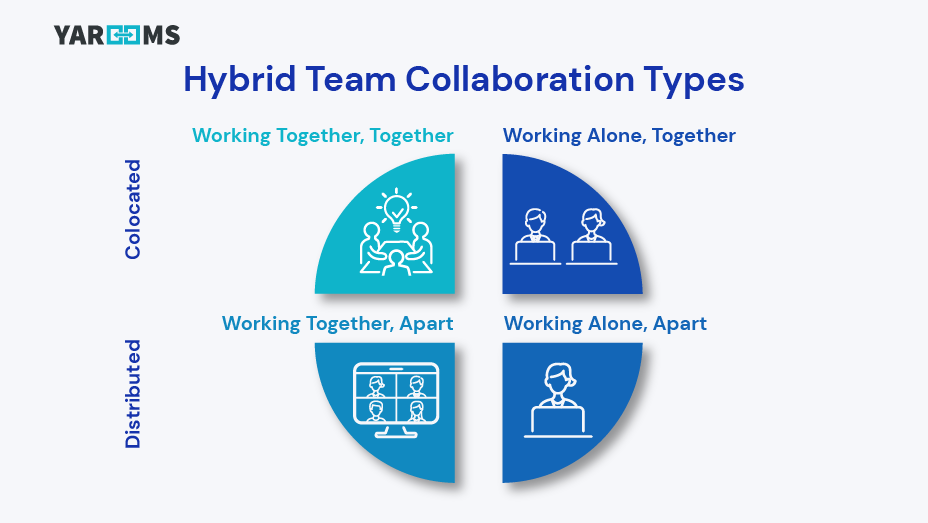Does this reality of working in a hybrid work environment sound (too) familiar to you:
32% of the participants in a Gallup survey reported decreased collaboration with their coworkers and a feeling of disconnection with their company’s culture since working in a hybrid set-up.
It does, doesn’t it?
As you, too, struggle with maintaining effective hybrid team collaboration:
- To balance the needs of everyone in your team: both remote and in-office workers
- To maintain team cohesion, making sure no team member feels left out
- To keep communication flowing smoothly in the context of tech hiccups and communication glitches
- To maintain productivity across different work environments
- To foster genuine connections
It is challenging, but… manageable.
With the right strategy and the right tools.
And in this post, you’ll learn exactly what are the most effective strategies and essential tools to help you overcome this challenge. And thrive.
TDLR:
- Hybrid team collaboration presents challenges like balancing remote and in-office needs, maintaining cohesion, overcoming communication glitches, and sustaining productivity.
- Understanding the four 5 types of hybrid collaboration types offers tailored strategies.
- Key strategies include setting clear expectations, overcoming hurdles, enhancing communication, and maximizing time together.
- Leveraging technology and emerging trends like automation and AI enhances hybrid teamwork efficiency
Understanding Hybrid Team Collaboration
Hybrid collaboration is a form of team collaboration where the team is mixed: some team members are working in the physical office and some remotely.
This type of team collaboration combines the best of both worlds: the traditional office environment with the flexibility of working remotely.
And, in most cases, it's the team itself that sets the rules for collaborating together in a hybrid setup:
- some select specific days for deep-focus, alone work time
- some select specific days for coming into the office for in-person collaboration
- some only come together for specific team meetings

4 Types of Hybrid Team Collaboration
Hybrid collaboration can be of 4 different types:
- Working Together, Together
- Working Alone, Together
- Working Together, Apart
- Working Together, Apart
With hybrid teams alternating between them depending on:
- specific circumstances they need to adapt to for blending virtual and in-person collaboration, teamwork, and communication
- the need to make the most of their together time
And here are these 4 different types of team collaboration in a hybrid work environment.
Each of them offers specific strategies to ensure effective communication between remote and in-person team members:
Working Together, Together
This is when you have the entire team in the same location engaged in the same meeting. Or working on the same task. Or brainstorming together.
When is this type of hybrid collaboration most effective?
When the team is challenged to solve a bigger problem. Or to make critical decisions.
Working Alone, Together
This means the hybrid team is sharing the same workspace, but they’re not working on the same task. Nor at the same time.
Just picture a regular day at the office – in a hybrid workplace – when all the team members are in the office, with each of them working on their own tasks.
It’s an effective type of hybrid collaboration, usually adopted once or twice a week, as it:
- eases information sharing
- streamlines communication
- strengthens team cohesion
… with team members being able to socialize and have those interpersonal chats that are so critical for building a healthy, cohesive team.
Working Together, Apart
It’s similar to the “working together, together” type of hybrid communication, except for the fact that here the team is not working from the same place.
Even though they’re all working on the same task. Or are engaged in the same virtual meeting or problem-solving session.
Such an approach to hybrid workforce collaboration is most effective for progress reports, quick catch-ups between team members, or daily standup meetings.
Working Alone, Apart
It’s when the team members are working from different locations. With each of them doing deep-focus work on his own respective task.
When is this type of hybrid team collaboration most effective?
When team members need to get really focused on their individual tasks, with minimal distractions.

Why Is Hybrid Collaboration Essential in the Modern Workplace?
Because it:
- enhances effective communication
- fuels productivity
- … and innovation
- strengthens team cohesion
… which becomes particularly important (and challenging) when you have team members working both in the office and remotely.
With the right tools and effective strategy to facilitate hybrid collaboration among team members, you’ll be able to reap the benefits that come with it.
Like lower office overheads.
Without having to trade workplace efficiency and productivity for that.
What Are the Main Collaboration Challenges Faced by Hybrid Teams?
- maintaining coordination (and cohesion) between in-office and remote team members
- overcoming communication barriers stemming from time zone and distance differences
- addressing technological issues. And privacy concerns.
These are the 3 main challenges that hybrid teams face while striving to collaborate seamlessly, effectively, and efficiently.
And yet, with the right strategy in place, you’ll be properly equipped to address these challenges, overcome them, and strengthen collaboration between teams.
Strategies for Effective Hybrid Collaboration
One in two hybrid and remote workers think their managers don’t follow management best practices, stressing the importance of effective leadership in supporting effective collaboration between teams.
And speaking of the right strategies that managers can adopt to enhance (effective) hybrid collaboration, here are the 8 most effective ones:
Establishing Clear Expectations and Guidelines for Hybrid Work
Without policies that set clear expectations for your hybrid teams, you risk having your employees:
feel more and more disconnected from the companynot being able to meet the company’s productivity and efficiency goals
Also, without any clear guidelines outlined for hybrid work, you’ll face the challenge of dealing with multiple working styles:
Employees working remotely will feel constrained to come up with their own particular ways of solving problems they’re challenged with during their work. Which leads to inconsistencies and discrepancies.
To avoid and easily overcome these types of challenges, you’ll want to have:
- clearly communicated timelines
- standardized operating procedures
- work tools guidelines
- hybrid communication policies
- … set in place.
Overcoming Social, Technical, and Collaborative Hurdles
What do you do to avoid your hybrid team members from feeling disconnected from the social life at work?
That social life that bonds employees to the organization, creates meaning and that valuable sense of belonging?
You strive to foster an inclusive culture.
How? Using the right communication funnels to support and enhance all the types of inter-team communication needed, depending on the context: weekly feedback, real-time document-sharing, brainstorming sessions…
… excluded from important projects and team meetings.
As for the tech issues that come up and turn collaboration and teamwork into discouraging ordeal, the solutions are:
- backup procedures
- reliable systems set in place
Enhancing Communication and Engagement Across Remote and In-Person Teams
The right communication tools + encouraging active participation in team meetings + a culture of inclusivity and transparency.
This is the 3 pillar formula to streamline communication and boost engagement across your hybrid teams.
By promoting open dialogue and active listening and empowering your employees with reliable communication tools and protocols, you’ll be able to create that engaging and collaborative environment for both in-house and remote team members.
Optimizing Hybrid Meetings for Maximum Efficiency
Because yes, ineffective hybrid meetings are one of the key culprits for poor hybrid team collaboration.
With team members at these meetings feeling disengaged and unable to find the opportunity to actively contribute to the virtual discussions.
And here are your best tactics for making hybrid meetings more engaging, more effective:
- Let everyone know what the meeting’s purpose is, in advance, and engage them with actionable tasks at the end of the meeting
- Rely on visual reminders to engage remote workers in ongoing conversations
- Opt for a meeting room booking software that’s highly accessible to everyone, so they can book and schedule with no hassle

Implementing Inclusive Communication Tools and Practices
Invest in tools that support multiple languages and different accessibility options.
And promote inclusive communication best practices like:
Inviting all team members to key briefings
Encouraging both in-person and remote team members to participate in core workgroups
These are all part of the strategy that creates that culture of collaboration and engagement that’s critical even so more in a hybrid work environment
Maximizing Together Time for Seamless Collaboration
Here are 3 simple and effective tactics to get the most out of that time:
Invest in an efficient hybrid work planning calendar, which allows everyone to see who’s in the office and when, and plan their hybrid schedules for teamwork accordingly.Come up with a detailed meeting agenda and a list of clear expectations before every hybrid collaboration session
Keep the momentum going even after the meeting, asynchronously, using a digital collaboration tool that ensures easy access and quick updates
This way, everyone’s certain they don’t forget the key points discussed and the action plan after the meeting.
Implementing Policies to Ensure Equal Participation and Inclusivity
Picture this: an introverted team member working remotely in a virtual meeting with his colleagues who’re all collocated in the same office. And who feel more at ease to intervene in the conversation, take turns, and influence decision-making.
Since you don’t want all the conversations taking place during your hybrid meetings to be dominated by the in-person employees – leaving their remote colleagues no chance to contribute – what you’ll want to do avoid this is:
Incorporate intentionally designed activities in your hybrid collaboration sessions to ensure balanced communication and equal participation.
Planning Virtual Social Events and In-Person Gatherings for Enhanced Team Cohesion
As a leader, you’ll want to strive, constantly, to create a sense of belonging and… community within your hybrid team.
How?
Organize:
- social events
- recognition programs that enhance employees to engage
- team-building activities
- in-person gatherings that strengthen team cohesion and build relationships across team members; both in-house and remote ones
Modern Technology Tools for Seamless Hybrid Team Collaboration
This means technology that:
- is flexible enough
- facilitates effective hybrid communication
- enables teamwork between in-office and remote co-workers
- enhances hybrid collaboration, regardless of the team members’ work location
- provides transparency on team members’ work schedules
- caters to the specific needs of employees in various locations
And the list of modern technology tools for smooth hybrid collaboration includes:
- video conferencing platforms
- virtual team collaboration platforms
- project management software
- workplace experience platforms
Speaking of the latter, YAROOMS stands out as that complete workplace experience platform that’ll cater to all your needs as a leader striving to achieve effective collaboration within your hybrid team(s):
- Hybrid work planning solution
- Desk, meeting rooms, and other office area booking solution
- Digital signage
- Opportunities for constantly improving employee experience by boosting the UX of your workplace as needed, fast and efficiently
Examples of Successful Hybrid Collaboration in Action
What better way to figure out the best tools and strategies to use to ensure effective hybrid team collaboration than by getting inspired by others’ success stories?
And here are 2 such case studies, both sharing YAROOMS as the technology that makes smooth hybrid collaboration possible:
Dr. Martens’ and The Benefits of Transparency in Enhancing Hybrid Collaboration
The company relied on YAROOMS’s space management system to ensure that:
- their employees would fit into the smaller space available in their flexible office
- everyone can visually navigate the workplace themselves and get quick access to information on what deks are booked, when, and by whom
- any employee can easily book a space near a team member he plans to collaborate with on a specific day
Et voila! With everyone knowing where, when, and next to whom they’ll sit when they come into the office, collaboration becomes smoother. And more effective.
Saipem and Their Work Planning Calendar-Like Tool
Saipem managed to offer its hybrid team members the flexibility they needed to create their own hybrid work schedules – work in the office, work from home, or on vacation –
And enhance hybrid collaboration.
Addressing Common Misconceptions About Hybrid Team Collaboration
Misconception #1: Employees are less productive when they work outside the physical office.
This is probably the most common misconception about hybrid workforce collaboration.
How do you overcome it?
Addressing, ahead of time, any tech issues that risk affecting your teams’ productivity. And optimizing all hybrid meetings taking place.
Misconception #2: Hybrid teams cannot collaborate as seamlessly and effectively, nor strengthen their team cohesion when they’re now in the physical office.
This is the second most common misconception.
How do you address it? Invest in the right collaboration and hybrid communication tools.
Misconception #3: Companies who’ve adopted a hybrid work model are more prone to security risks and data breaches.
Having solid security protocols set in place helps you address this misconception related to hybrid work.
New Trends in Hybrid Team Collaboration
Here are 5 trends that you can exploit to improve collaboration for your hybrid team:
Automation
Aim at automating an increasingly large portion of your hybrid teams’ tasks.
Particularly those tedious, repetitive, time-consuming ones.
This will free up time for team members to collaborate, engage in teamwork, and share information more effectively.
AI and machine learning
According to a Dialpad survey, 82% of respondents believed that AI will boost productivity and 27% were already using generative AI for work-related tasks. This shows a growing trend towards capitalizing on advanced technologies for effective collaboration.
The right AI tools will give your dispersed team members access to powerful insights to help them tackle the problems they might face during their work.
And they’ll enhance collaboration across the entire hybrid team.
Adopting tech that supports hybrid teamwork
You’ll want to invest in robust technology that supports hybrid work and seamless collaboration across dispersed teams.
Robust technology that’ll help your hybrid teams thrive.
Think cloud solutions, expanding VPN capacity, and adopting SaaS apps.

Asynchronous collaboration
Sticking to a rigid 100% synchronous collaboration is both challenging and… ineffective for hybrid teams working from various locations and time zones.
Embrace asynchronous work policies instead, that are more inclusive and cater to your employees’ multiple work schedules.
How? With the help of the right digital tools, they can work in teams… synchronously.
Instead of sticking to real-time meetings only.
AR and VR
Think virtual office spaces – the cost-effective and easier-to-access alternatives to the physical ones – that enhance effectiveness and more… natural collaboration among colleagues.
Such simulations of real-life collaboration sessions and team meetings do come to support hybrid team connection and productivity.
Conclusion: Embracing the Potential of Hybrid Team Collaboration
Cost savings, fewer office overheads, increased productivity and efficiency, higher sustainability…
These are all too valuable benefits that you can reap by supporting and constantly seeking opportunities to improve collaboration between teams in your work model set-up.
Wouldn’t you agree that these benefits weigh heavier than the challenges of hybrid work and the hurdles you’ll need to address to maintain a high level of collaboration?












